Productivity is in decline! There are several reports stating that average productivity is declining, The reasons: sleep deprivation, low employee engagement, stress- and distraction due to working at open plan offices...
Complexity grows! Gone are the days when unstructured multitasking was considered a talent and presented in flying colors. The abundance of different tasks within modern project management makes multitasking virtually impossible - it even makes it a serious productivity killer. What this situation requires instead are well structured workflows.
Kanban provides structure and banishes multitasking!
Luckily, there are methodologies, frameworks, and tools that support team workflows and help to increase their productivity again. Kanban is one of them. Kanban, which translates to “visual map” - was originally developed in the 1940s in Toyota factories - and it still is a first-choice project management method as soon as a multitude of tasks need to be assigned.
In short, the allocation of tasks is presented visually on a board, which not only reflects the current status of the individual tasks, but also the overall picture / development of the project.
What used to be held on physical boards in factories and offices, is now done digitally. To avoid multitasking, Kanban also prescribes a work-in-progress (WIP) limit. This is to prevent those involved from losing productivity by simultaneously processing multiple tasks.
Although Kanban is a well-established framework, the project management tools offered on the market are far from being identical. The methodology itself is used in various forms and sometimes combined with other approaches. Thus, some of the tools include quite different functions and user interfaces. The variety ranges from a simple Kanban board to comprehensive all-in-one project management software.
What makes a good Kanban tool?
Before we move on to present and compare 5 popular Kanban tools, we’ll analyze what makes a good Kanban tool. Of course, the final choice depends on the specific needs of the company's projects, its budget, aesthetic judgment, etc. Nevertheless, there are some universal factors that should be taken into consideration when making the final choice.
The Kanban Board
The way the board is organized and how it looks is quite obviously the most significant factor in choosing the Kanban tool.
- Which workflows are supported?
- How are columns and statuses arranged and subdivided?
- How are the Kanban cards structured? Are there sub-tasks, deadlines and can you attach or link detailed information and files?
- What about the handling?
Collaboration
Although Kanban can be implemented just as well for an individual project, it’s commonly used to manage teamwork. That’s why it’s important have a look at how collaboration has been implemented:
- How do employees communicate?
- How does the assignment of tasks work? Is there an acceptance workflow?
- How are multiple projects represented by the software?
- Can external employees be involved as well?
Support
In case of user issues or questions about more complex operations, reliable and fast support is essential. A good provider should offer first-class support through various channels (phone support, live chat, FAQ, webinars, etc.).
Security
When managing projects, also sensitive information is exchanged quite often:
- Project-relevant information that should not leaked out (especially not to the competition)
- Sensitive files and documents
- Passwords / Logins
- Data from customers and partners (including personal identifiable data), etc.
- Discussions between the project participants
The best Kanban tool is also the one that doesn’t neglect security, offers encryption, two-factor authentication, and that is GDPR-compliant.
5 popular Kanban tools: Stackfield, Trello, Monday, MeisterTask, Asana
1. Stackfield
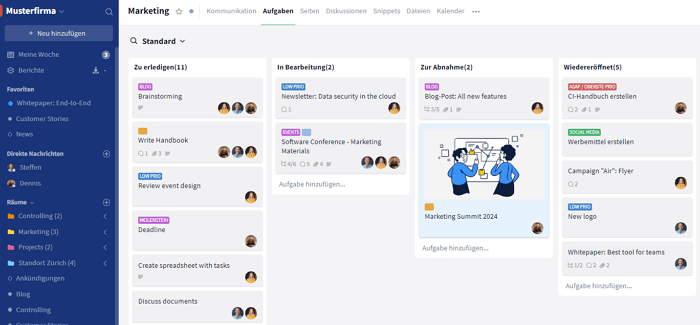
Stackfield combines project management, collaboration and high security standards. Next to multiple modules, Stackfield also includes a Kanban board making it more versatile than other tools. The Kanban board is flexible and allows for custom workflows to best suit the needs of the team. Columns can be added, moved or deleted as required, individually named and incorporated into rights groups. For example, it is possible to define exactly to whom tasks should be assigned for acceptance. Tasks can be easily moved in the Kanban board (as well as in the list view) by drag & drop.
However, what differentiates Stackfield's Kanban processes from those of other tools is their reasonable embedding into other collaboration areas. Board and communication module are directly related to each other: tasks can be created, for example, within the team chat and all elements - may it be tasks, documents or files - can be directly commented on, whereby the context is always maintained.
In order to be able to guarantee the protection of all information at any time, Stackfield encrypts all data right within the browser using a client-side end-to-end encryption. This ensures that nobody else, not even Stackfield's operators, gets access to users' data.
Stackfield's prices are based solely on the number of users and storage capacity, i.e. even users of smaller packages do not have to sacrifice functionality. Only the Enterprise version has extended features that make it easier to organise a large number of users and manage several organisations under one roof. Stackfield is also offered as an on-premise version.
2. Trello
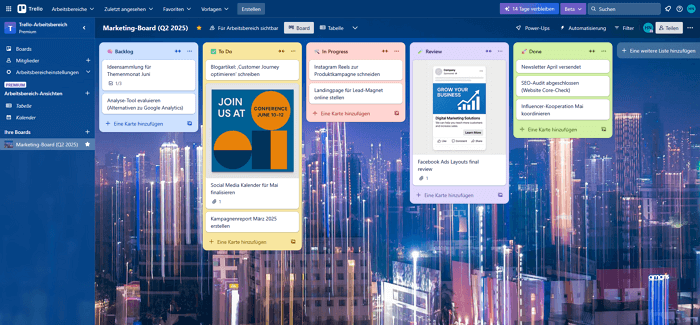
Those looking for a Kanban tool, will inevitably end up with Trello. This tool is all about the Kanban framework. In fact, you can see that Trello focuses on an easy-to-use interface. It doesn’t offer many additional project management or collaboration features. Trello captures all information (tasks with labels, appointments, files, comments, etc.) on cards that can be easily switched within the project board by using the drag & drop function. In short: Its simple interface consists of a flexible Kanban board, file exchange, labels, checklists, commenting, offers a few integrations and power-ups but not much more.
Basic features are available with Trello in a free plan limited to 10 boards. Additional options, including email notifications, data export and advanced automation are available only in paid plans.
3. Monday
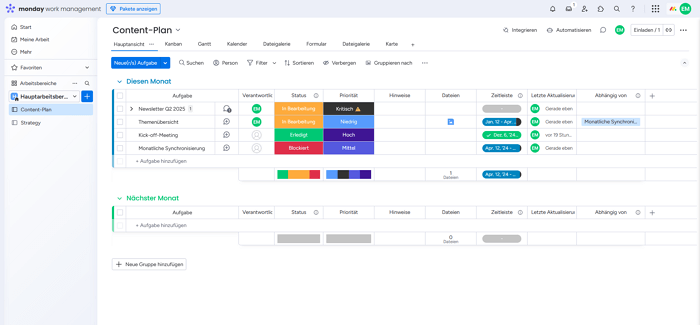
Also Monday, being a quite complex project management tool offers a Kanban board. A board can be created directly from the main dashboard before it can be adjusted to the needs of the user. Monday also offers a calendar view, time tracking, advanced search and file storage. What differentiates Monday from other project management tools are various ways to customize the user interface and workflow, based on customized, ready-to-use templates and drag-and-drop elements. It also offers automations - for example, it’s possible to set to notify the entire team when certain tasks have been completed.
Monday.com can be booked in five different plans, with prices per user increasing with each plan. Extended functions, such as a calendar view or time recording, are only available in higher-priced plans.
4. MeisterTask
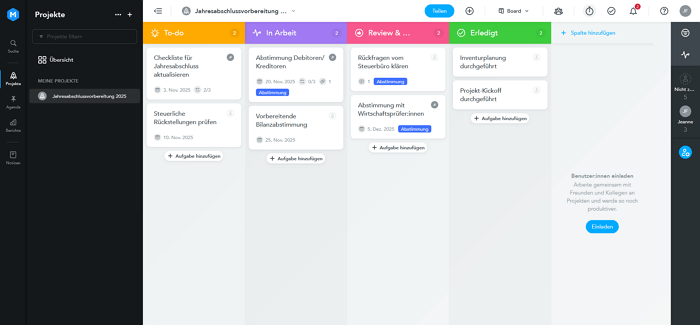
MeisterTask is a project management tool with a focus on creativity. The Kanban boards are flexible, allowing for adjusting different items to the user's needs: columns can be added, deleted, named and highlighted in colors and also relations between single tasks (e.g. task 2 can only be started when task 1 has been completed) can be set individually to provide a better overview. The heart of the tool is the dashboard that allows for setting up the priorities and presents a quick overview of all the tasks. Apart from a browser view, the tool can be also downloaded as both a desktop and mobile app. Its parent company MeisterLab has also created a mind mapping tool that can be seamlessly connected with MeisterTask in form of a Bundle-Version.
There is a free version for individuals. Team collaboration only works in the paid versions.
5. Asana
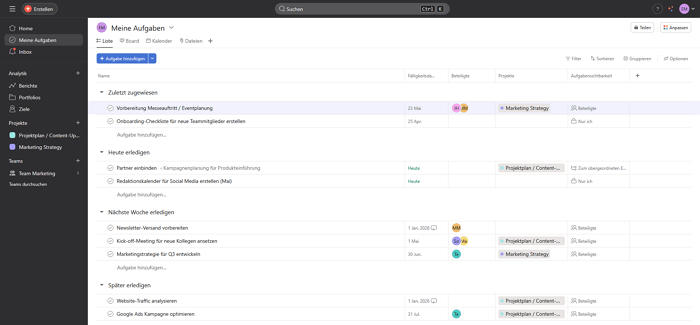
Asana’s functionality, too, goes beyond a simple Kanban board, additionally offering a calendar and a to-do checklist view. The tool also allows sharing and commenting files. However, there is no option for time recording integrated directly. The Kanban view is organized in a traditional way: board, labels, assignment of tasks and subordinate tasks. These features are available in a free plan (up to 10 users). Extended functions, e.g. timeline, time recording or extended security functions are only offered in the paid versions.
Choose the Kanban tool that suits your team best. Interestingly, companies that promote collaboration are 5x more likely to be high performing. That’s precisely why you should take advantage of project management tools to visualize the project’s processes, encourage collaboration and track the overall progress of your teams. This keeps everyone motivated and productive, helping them always stay to top of the things, even in stressful situations.